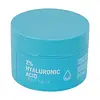What's inside
What's inside
 Key Ingredients
Key Ingredients

 Benefits
Benefits

 Concerns
Concerns

No concerns
 Ingredients Side-by-side
Ingredients Side-by-side

Water
Skin ConditioningGlycerin
HumectantButylene Glycol
HumectantHyaluronic Acid
HumectantPhenyl Trimethicone
Skin ConditioningDimethicone
EmollientTrehalose
HumectantHydrogenated Polyisobutene
EmollientPhenoxyethanol
PreservativeBenzyl Alcohol
PerfumingChlorphenesin
AntimicrobialCarbomer
Emulsion StabilisingJasminum Officinale Oil
MaskingTocopherol
AntioxidantSodium Hydroxide
BufferingSimmondsia Chinensis Seed Oil
EmollientWater
Skin ConditioningDipropylene Glycol
HumectantGlycerin
HumectantGlycereth-26
HumectantCamellia Japonica Flower Extract
EmollientPaeonia Albiflora Flower Extract
TonicNelumbo Nucifera Flower Extract
Skin ConditioningNelumbo Nucifera Leaf Extract
Skin ConditioningNelumbo Nucifera Root Extract
Skin ConditioningNelumbo Nucifera Seed Extract
AntimicrobialSodium Hyaluronate
HumectantButylene Glycol
Humectant1,2-Hexanediol
Skin ConditioningDipentaerythrityl Pentaisononanoate
EmollientDimethicone
EmollientCarbomer
Emulsion StabilisingDimethicone/Vinyl Dimethicone Crosspolymer
Skin ConditioningC12-14 Pareth-12
EmulsifyingHydroxyethyl Acrylate/Sodium Acryloyldimethyl Taurate Copolymer
Emulsion StabilisingSqualane
EmollientPolysorbate 60
EmulsifyingSorbitan Isostearate
EmulsifyingTromethamine
BufferingAmmonium Acryloyldimethyltaurate/Vp Copolymer
Trehalose
HumectantTocopheryl Acetate
AntioxidantEthylhexylglycerin
Skin ConditioningDisodium EDTA
Phenoxyethanol
PreservativeWater, Dipropylene Glycol, Glycerin, Glycereth-26, Camellia Japonica Flower Extract, Paeonia Albiflora Flower Extract, Nelumbo Nucifera Flower Extract, Nelumbo Nucifera Leaf Extract, Nelumbo Nucifera Root Extract, Nelumbo Nucifera Seed Extract, Sodium Hyaluronate, Butylene Glycol, 1,2-Hexanediol, Dipentaerythrityl Pentaisononanoate, Dimethicone, Carbomer, Dimethicone/Vinyl Dimethicone Crosspolymer, C12-14 Pareth-12, Hydroxyethyl Acrylate/Sodium Acryloyldimethyl Taurate Copolymer, Squalane, Polysorbate 60, Sorbitan Isostearate, Tromethamine, Ammonium Acryloyldimethyltaurate/Vp Copolymer, Trehalose, Tocopheryl Acetate, Ethylhexylglycerin, Disodium EDTA, Phenoxyethanol
Ingredients Explained
These ingredients are found in both products.
Ingredients higher up in an ingredient list are typically present in a larger amount.
Butylene Glycol (or BG) is used within cosmetic products for a few different reasons:
Overall, Butylene Glycol is a safe and well-rounded ingredient that works well with other ingredients.
Though this ingredient works well with most skin types, some people with sensitive skin may experience a reaction such as allergic rashes, closed comedones, or itchiness.
Learn more about Butylene GlycolCarbomer is a polymer of acrylic acid. Its main role is to create a gel consistency.
A high amount of carbomer can cause pilling or balling up of products. Don't worry, most products contain 1% or less of carbomer.
Dimethicone is a type of synthetic silicone created from natural materials such as quartz.
What it does:
Dimethicone comes in different viscosities:
Depending on the viscosity, dimethicone has different properties.
Ingredients lists don't always show which type is used, so we recommend reaching out to the brand if you have questions about the viscosity.
This ingredient is unlikely to cause irritation because it does not get absorbed into skin. However, people with silicone allergies should be careful about using this ingredient.
Note: Dimethicone may contribute to pilling. This is because it is not oil or water soluble, so pilling may occur when layered with products. When mixed with heavy oils in a formula, the outcome is also quite greasy.
Learn more about DimethiconeGlycerin is already naturally found in your skin. It helps moisturize and protect your skin.
A study from 2016 found glycerin to be more effective as a humectant than AHAs and hyaluronic acid.
As a humectant, it helps the skin stay hydrated by pulling moisture to your skin. The low molecular weight of glycerin allows it to pull moisture into the deeper layers of your skin.
Hydrated skin improves your skin barrier; Your skin barrier helps protect against irritants and bacteria.
Glycerin has also been found to have antimicrobial and antiviral properties. Due to these properties, glycerin is often used in wound and burn treatments.
In cosmetics, glycerin is usually derived from plants such as soybean or palm. However, it can also be sourced from animals, such as tallow or animal fat.
This ingredient is organic, colorless, odorless, and non-toxic.
Glycerin is the name for this ingredient in American English. British English uses Glycerol/Glycerine.
Learn more about GlycerinPhenoxyethanol is a preservative that has germicide, antimicrobial, and aromatic properties. Studies show that phenoxyethanol can prevent microbial growth. By itself, it has a scent that is similar to that of a rose.
It's often used in formulations along with Caprylyl Glycol to preserve the shelf life of products.
Trehalose is a disaccharide made of two glucose molecules (glucose is sugar!). Trehalose is used to help moisturize skin. It also has antioxidant properties.
As a humectant, trehalose helps draw moisture from the air to your skin. This helps keep your skin hydrated.
Due to its antioxidant properties, trehalose may help with signs of aging. Antioxidants help fight free-radical molecules, unstable molecules that may damage your skin.
In medicine, trehalose and hyaluronic acid are used to help treat dry eyes.
Some animals, plants, and bacteria create trehalose as a source of energy to survive freeze or lack of water.
Learn more about TrehaloseWater. It's the most common cosmetic ingredient of all. You'll usually see it at the top of ingredient lists, meaning that it makes up the largest part of the product.
So why is it so popular? Water most often acts as a solvent - this means that it helps dissolve other ingredients into the formulation.
You'll also recognize water as that liquid we all need to stay alive. If you see this, drink a glass of water. Stay hydrated!
Learn more about Water